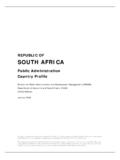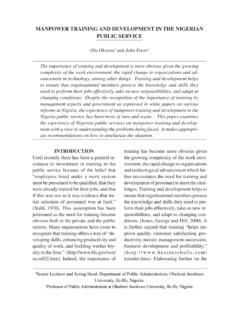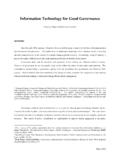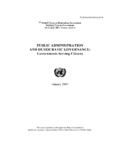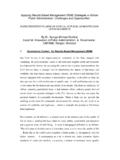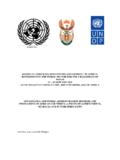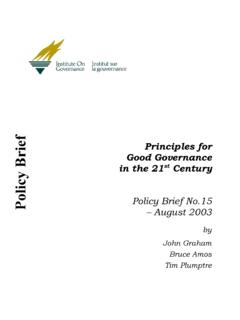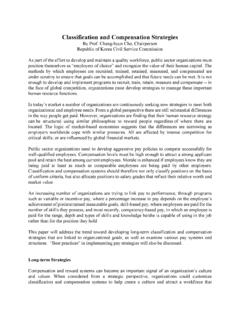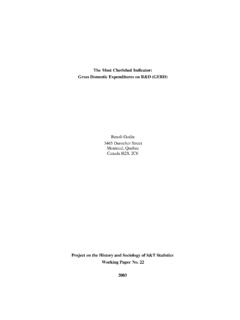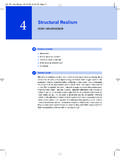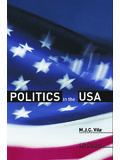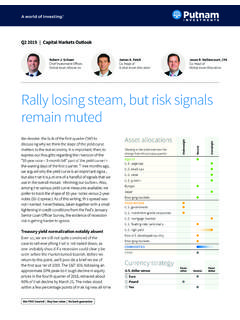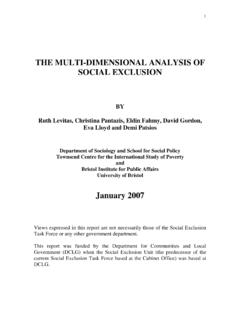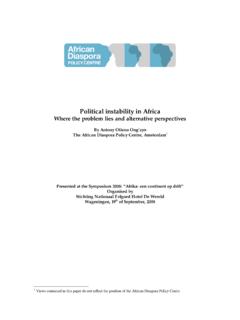Transcription of Bureaucratic Politics Dec 12 2 - United Nations
1 1 Bureaucratic Politics and Administrative Reform: Why Politics Matters Bidhya Bowornwathana, Chulalongkorn University, Thailand Ora-orn Poocharoen, Lee Kuan Yew School of Public Policy, Singapore 2 Bureaucratic Politics and Administrative Reform: Why Politics Matters Bidhya Bowornwathana Ora-orn Poocharoen Key word: Bureaucratic Politics , administrative reform, Politics , administration Abstract Administrative reform is a political, not managerial, issue. This study argues that administrative reform is highly influenced by realities of Bureaucratic Politics . Reforms usually mean the struggle over power between involved actors. There are evidences of patterns of power struggle among and between politicians and bureaucrats. Including contestation among bureaucrats that are responsible for public management reform.
2 These power struggles and contestations explain the decision-making processes for designing and implementing administrative reform policies and shifts of power relations. This article proposes a new framework to advance the concept of Bureaucratic Politics , with reference to administrative reform policy. It highlights the missing link between public policy and public management reform literature by revisiting the power of politicians and bureaucrats in making reform policies. INTRODUCTION A country s administrative reform policy and its Politics are deeply interconnected. The making of reform policies is politically-driven. The implementation of reform policies produces far-reaching political consequences to all parties concerned. Administrative reform programs reallocate the power balance among government agencies, in particular, among politicians and bureaucrats and among bureaucrats themselves.
3 Throughout the years, streams of reform fashions have come and go. Today s fashions of administrative reform such as governance and new public management are political instruments for reformers to satisfy their domain-expansion ambitions, power aggrandizement and consolidation. From a political perspective, the question about administrative reform is which actors have eventually acquired more power and which actors have less power, once a reform has been implemented, and why is it so. These enquiries fall under the concept of Bureaucratic Politics . 3 This paper aims to elaborate on a more advanced framework of Bureaucratic Politics to use for explaining administrative reforms. The framework has three aspects of focus: different pairing of actors relations politicians vs.
4 Politicians, politicians vs. bureaucrats, bureaucrats vs. bureaucrats; different levels of reform policy elements the rhetoric, policy, legislative level and the managerial tool level; and different results of reform based on shifts in power domain and the chosen management tools. Examples of Bureaucratic Politics of administrative reform in several countries such as Thailand, Malaysia, the United Kingdom, Japan, Italy, Australia, and Canada are drawn to show the dynamics of the Bureaucratic Politics framework. THE Bureaucratic Politics FRAMEWORK (BPF) Studies in public administration and public policy have long argued that governments are not one entity. Rather they are made up of many bureaus and departments that are constantly trying to protect their turf and maintain or increase their power (Allison, 1971; Halperin, 1974; Allison and Halperin, 1972; Kingdon, 1995; Peters, 2001).
5 The most well-known description of a Bureaucratic Politics model is the one proposed by Graham T. Allison (1971) to explain foreign policy decision-making in the Cuban Missile Crisis of October 1962. Subsequently, by illustrating cases of foreign policy decision-making in the during the Cold War era, Halperin (1974) introduced the Politics within a government as the concept of Bureaucratic Politics . Garry Clifford (1990: 168) argues that by focusing on Bureaucratic Politics , which emphasizes individual values and the tugging and hauling of key players we are able to understand who wins and why. Akin to public choice theories in public administration (Down, 1967; Niskanen, 1971), Bureaucratic Politics is an important factor to explain the policy decision-making process. Building from the classical model, political scientists have modified and develop the concept throughout the years.
6 An example is the adaptive model of Bureaucratic Politics by Bendor and Moe (1984), where they proposed a new framework built on neoclassical approaches of Niskanen (1971) and Peltzman (1976). The distinctness of their model is the incorporation of Simon s (1947) behavior tradition, in addition to identifying three actors: bureaus, politicians, and interest groups. 4In order to further advance the concept of Bureaucratic Politics and explore its usefulness in analyzing administrative reforms, the authors would like to propose a framework to study Bureaucratic Politics in the setting of administrative reforms. In linking the two concepts of Bureaucratic Politics and administrative reforms, one can use both concepts as an independent or dependent variable. That is to say, the phenomenon of Bureaucratic Politics can be used to explain aspects of administrative reform policies.
7 While, at the same time, the phenomenon of administrative reform can, also, be used to explain the changes in power relations of Bureaucratic Politics . Discussions of administrative reform, in general, have sporadically but not systematically included this important, domestic institutional variable of Bureaucratic Politics into its theories. Compared to Allison s classical Bureaucratic Politics model, this paper proposes a broader interpretation of the Bureaucratic Politics framework. The notion of Bureaucratic Politics is used to explain the political process of administrative reform, not just single decisions in a crisis situation. It goes beyond a policy making focus to cover policy implementation and impact studies of administrative reform. In this regard, the BPF proposes to examine a longer time-frame perspective than the classical Bureaucratic Politics model.
8 In addition, the classical model identifies actors as a small group of individuals holding key government positions. The BPF, however, covers a broader range of actors who are politicians and bureaucrats that are involved and affected by administrative reform. Lastly, the proposed BPF incorporates not only high level public officials but also mid and low level public officials as well. The proposed BPF consists of three aspects. The first aspect focuses on the types of actors and relations between the actors. The second aspect examines how administrative reform policies and tools are used as instruments in Bureaucratic Politics relations. And the third aspect discusses the results of reform in terms of shifts in power relations and changes in managerial practices of the public administration. Each aspect is described in detail as follows.
9 5 Figure 1: The Bureaucratic Politics Framework (BPF) I. RELATIONS BETWEEN ACTORS Administrative reform is a struggle for power and control among various politician and bureaucrat actors. The victorious side in the battle for power ends up expanding their domain and turf in government. While the losers relative power lessened. Thus, the word Bureaucratic Politics in administrative reform is used to describe the political games of bargaining, pulling and hauling, that goes on among and between politicians and bureaucrats to push for administrative reforms in government which would increase one s relative power in government. In this Bureaucratic Politics framework, there are several types of power relations among and between politicians and bureaucrats. First is the relation between politicians and bureaucrats.
10 Second is the relation among bureaucrats, which can further be divided into relations between central agencies; between core agencies and line agencies; between line agencies; between high-level bureaucrats and mid/low-level bureaucrats; and between old-timer bureaucrats and new faces that have been assigned to the agency as part of the reform. And third is the relation among politicians. All three relations are interrelated and all effect the direction of reform policies and the types of managerial tools chosen. The details and examples of each type of Bureaucratic Politics relation are elaborated as follows. Relations Politician vs. Bureaucrat Bureaucrat vs. Bureaucrat Politician vs. Politician Reform Policy level Tool level Results Power Shift Managerial Changes 61. Politicians vs.
